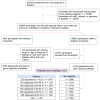Association of age at diagnosis of diabetes with subsequent risk of age-related ocular diseases and vision acuity
- PMID: 38680694
- PMCID: PMC11045417
- DOI: 10.4239/wjd.v15.i4.697
Association of age at diagnosis of diabetes with subsequent risk of age-related ocular diseases and vision acuity
Abstract
Background: The importance of age on the development of ocular conditions has been reported by numerous studies. Diabetes may have different associations with different stages of ocular conditions, and the duration of diabetes may affect the development of diabetic eye disease. While there is a dose-response relationship between the age at diagnosis of diabetes and the risk of cardiovascular disease and mortality, whether the age at diagnosis of diabetes is associated with incident ocular conditions remains to be explored. It is unclear which types of diabetes are more predictive of ocular conditions.
Aim: To examine associations between the age of diabetes diagnosis and the incidence of cataract, glaucoma, age-related macular degeneration (AMD), and vision acuity.
Methods: Our analysis was using the UK Biobank. The cohort included 8709 diabetic participants and 17418 controls for ocular condition analysis, and 6689 diabetic participants and 13378 controls for vision analysis. Ocular diseases were identified using inpatient records until January 2021. Vision acuity was assessed using a chart.
Results: During a median follow-up of 11.0 years, 3874, 665, and 616 new cases of cataract, glaucoma, and AMD, respectively, were identified. A stronger association between diabetes and incident ocular conditions was observed where diabetes was diagnosed at a younger age. Individuals with type 2 diabetes (T2D) diagnosed at < 45 years [HR (95%CI): 2.71 (1.49-4.93)], 45-49 years [2.57 (1.17-5.65)], 50-54 years [1.85 (1.13-3.04)], or 50-59 years of age [1.53 (1.00-2.34)] had a higher risk of AMD independent of glycated haemoglobin. T2D diagnosed < 45 years [HR (95%CI): 2.18 (1.71-2.79)], 45-49 years [1.54 (1.19-2.01)], 50-54 years [1.60 (1.31-1.96)], or 55-59 years of age [1.21 (1.02-1.43)] was associated with an increased cataract risk. T2D diagnosed < 45 years of age only was associated with an increased risk of glaucoma [HR (95%CI): 1.76 (1.00-3.12)]. HRs (95%CIs) for AMD, cataract, and glaucoma associated with type 1 diabetes (T1D) were 4.12 (1.99-8.53), 2.95 (2.17-4.02), and 2.40 (1.09-5.31), respectively. In multivariable-adjusted analysis, individuals with T2D diagnosed < 45 years of age [β 95%CI: 0.025 (0.009,0.040)] had a larger increase in LogMAR. The β (95%CI) for LogMAR associated with T1D was 0.044 (0.014, 0.073).
Conclusion: The younger age at the diagnosis of diabetes is associated with a larger relative risk of incident ocular diseases and greater vision loss.
Keywords: Age at diagnosis; Age-related macular disease; Cataract; Diabetes; Glaucoma; Vision acuity.
©The Author(s) 2024. Published by Baishideng Publishing Group Inc. All rights reserved.
Conflict of interest statement
Conflict-of-interest statement: The authors have no conflicts of interest to declare that are relevant to the content of this article.
Figures





References
-
- GBD 2019 Blindness and Vision Impairment Collaborators; Vision Loss Expert Group of the Global Burden of Disease Study. Causes of blindness and vision impairment in 2020 and trends over 30 years, and prevalence of avoidable blindness in relation to VISION 2020: the Right to Sight: an analysis for the Global Burden of Disease Study. Lancet Glob Health. 2021;9:e144–e160. - PMC - PubMed
LinkOut - more resources
Full Text Sources

